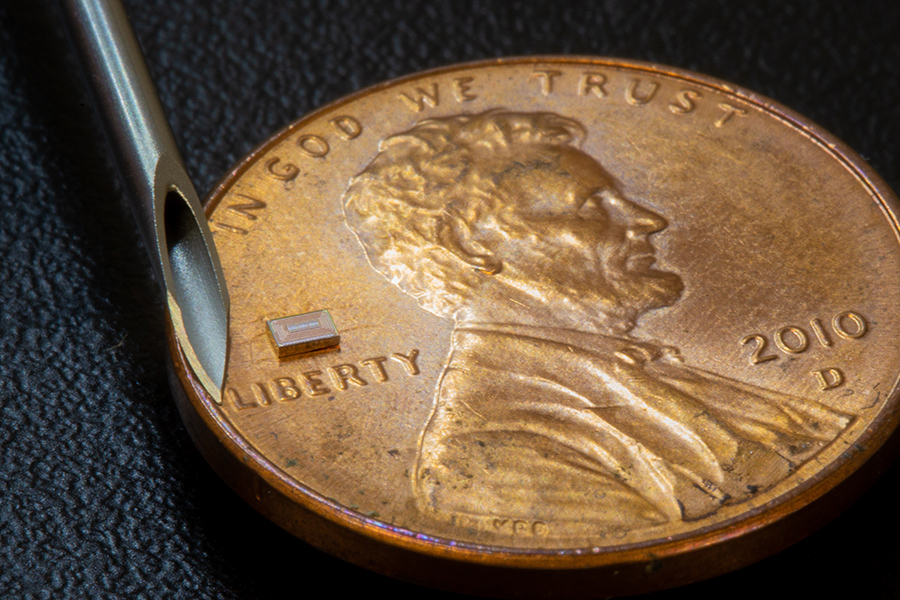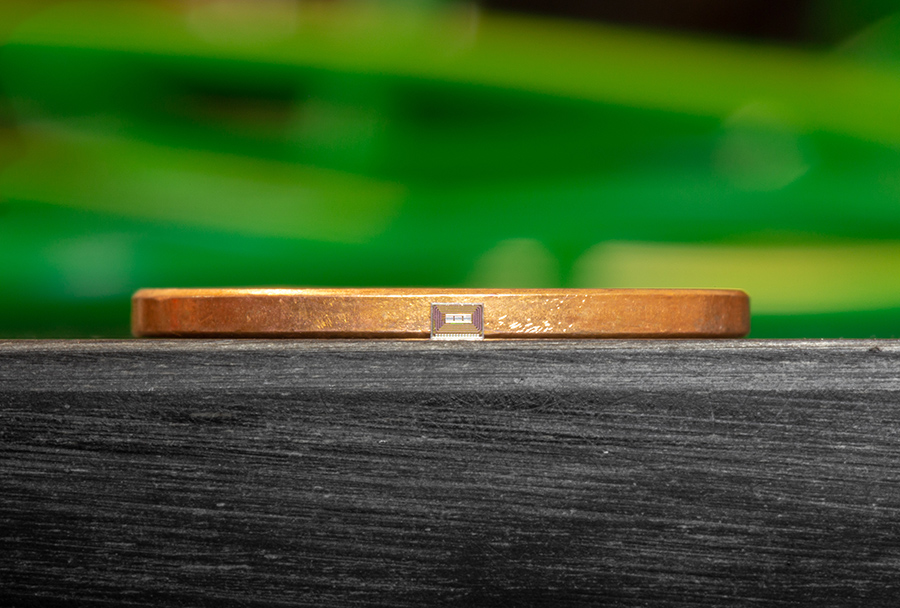
Engineers at the University of California San Diego have developed a miniature, ultra-low power injectable biosensor that could be used for continuous, long-term alcohol monitoring. The chip is small enough to be implanted in the body just beneath the surface of the skin and is powered wirelessly by a wearable device, such as a smartwatch or patch.
“The ultimate goal of this work is to develop a routine, unobtrusive alcohol and drug monitoring device for patients in substance abuse treatment programs,” said Drew Hall, an electrical engineering professor at the UC San Diego Jacobs School of Engineering who led the project. Hall is also affiliated with the Center for Wireless Communicationsand the Center for Wearable Sensors, both at UC San Diego. Hall’s team presented this work at the 2018 IEEE Custom Integrated Circuits Conference (CICC) on Apr. 10 in San Diego.
One of the challenges for patients in treatment programs is the lack of convenient tools for routine monitoring. Breathalyzers, currently the most common way to estimate blood alcohol levels, are clunky devices that require patient initiation and are not that accurate, Hall noted. A blood test is the most accurate method, but it needs to be performed by a trained technician. Tattoo-based alcohol sensors that can be worn on the skin are a promising new alternative, but they can be easily removed and are only single-use.
“A tiny injectable sensor—that can be administered in a clinic without surgery—could make it easier for patients to follow a prescribed course of monitoring for extended periods of time,” Hall said.
 The size of the alcohol monitoring chip compared to a penny and a 16 gauge needle
The size of the alcohol monitoring chip compared to a penny and a 16 gauge needleThe biosensor chip measures roughly one cubic millimeter in size and can be injected under the skin in interstitial fluid—the fluid that surrounds the body’s cells. It contains a sensor that is coated with alcohol oxidase, an enzyme that selectively interacts with alcohol to generate a byproduct that can be electrochemically detected. The electrical signals are transmitted wirelessly to a nearby wearable device such as a smartwatch, which also wirelessly powers the chip. Two additional sensors on the chip measure background signals and pH levels. These get canceled out to make the alcohol reading more accurate.
The researchers designed the chip to consume as little power as possible—970 nanowatts total, which is roughly one million times less power than a smartphone consumes when making a phone call. “We don’t want the chip to have a significant impact on the battery life of the wearable device. And since we’re implanting this, we don’t want a lot of heat being locally generated inside the body or a battery that is potentially toxic,” Hall said.
One of the ways the chip operates on such ultra-low power is by transmitting data via a technique called backscattering. This occurs when a nearby device like a smartwatch sends radio frequency signals to the chip, and the chip sends data by modifying and reflecting those signals back to the smartwatch. The researchers also designed ultra-low power sensor readout circuits for the chip and minimized its measurement time to just three seconds, resulting in less power consumption.
 The chip compared to the thickness of a penny
The chip compared to the thickness of a pennyThe researchers tested the chip in vitro with a setup that mimicked an implanted environment. This involved mixtures of ethanol in diluted human serum underneath layers of pig skin.
For future studies, the researchers are planning to test the chip in live animals. Hall’s group is working with CARI Therapeutics, a startup based in the Qualcomm Institute Innovation Space at UC San Diego, and Dr. Carla Marienfeld, an addiction psychiatrist at UC San Diego who specializes in treating individuals with substance abuse disorders, to optimize the chip for next generation rehab monitoring. Hall’s group is developing versions of this chip that can monitor other molecules and drugs in the body.
“This is a proof-of-concept platform technology. We’ve shown that this chip can work for alcohol, but we envision creating others that can detect different substances of abuse and injecting a customized cocktail of them into a patient to provide long-term, personalized medical monitoring,” Hall said.
Learn more: Tiny Injectable Sensor Could Provide Unobtrusive, Long-term Alcohol Monitoring
The Latest on: Injectable biosensor
[google_news title=”” keyword=”injectable biosensor” num_posts=”10″ blurb_length=”0″ show_thumb=”left”]
via Google News
The Latest on: Injectable biosensor
- Sciatic Nerve Injury Following Intramuscular Injection: A Case Report and Review of the Literatureon April 30, 2024 at 5:00 pm
When giving gluteal injections, it is safest to use the upper outer quadrant. The choice of site for injection must be based on good clinical judgment, using the best evidence available and ...
- Gentamicin Injectionon April 30, 2024 at 5:00 pm
This leaflet answers some common questions about Gentamicin Injection. It does not contain all the available information. It does not take the place of talking to your healthcare professional.
- Isoptin Injectionon April 29, 2024 at 5:00 pm
If you are worried about using this medicine, speak to your doctor or pharmacist. ISOPTIN injection contains the active ingredient verapamil hydrochloride. ISOPTIN injection is used to treat ...
- Etanercept Injection Site Reactionon April 28, 2024 at 5:00 pm
She started treatment with etanercept (Enbrel ®) 1 month previously. One day after a subcutaneous injection into the left thigh, she developed a mildly pruritic eruption on the right thigh ...
- Could you endure 40 jabs of 'injectable moisturiser' at a cost of £850 to smooth out wrinkly mummy tum?on April 27, 2024 at 2:10 pm
A 'transformative' injectable moisturiser which smooths wrinkles on the stomach, arms and bust is being offered at UK cosmetic clinics. The innovative procedure involves up to 40 jabs of diluted ...
- Injectable Contraceptives May Increase the Risk of Developing Brain Tumorson April 18, 2024 at 4:00 am
Study participants who had used medroxyprogesterone acetate — an injectable contraceptive commonly known as Depo-Provera — were at nearly 5.6 times the risk of developing meningioma than those who had ...
- Medincell, AbbVie link up in long-acting injectable development pact worth up to $1.9Bon April 17, 2024 at 7:49 am
After proving the merits of its drug delivery platform last year with the approval of Teva’s long-acting schizophrenia drug Uzedy, France’s Medincell has hooked another big-name partner.
- Roche touts near-complete suppression of multiple sclerosis relapse for injectable Ocrevuson April 17, 2024 at 4:00 am
One-year data continued to support a more convenient, injectable version of Roche’s blockbuster multiple sclerosis (MS) drug Ocrevus ahead of an FDA decision, the Swiss pharma said. A ...
- Your FAQs Answered: Lumbar Epidural Steroid Injectionon April 9, 2024 at 5:00 pm
In some cases, you may need additional injections to relieve pain. A doctor may recommend a lumbar epidural steroid injection to help manage pain that originates from your lower spine. But it isn ...
via Bing News











